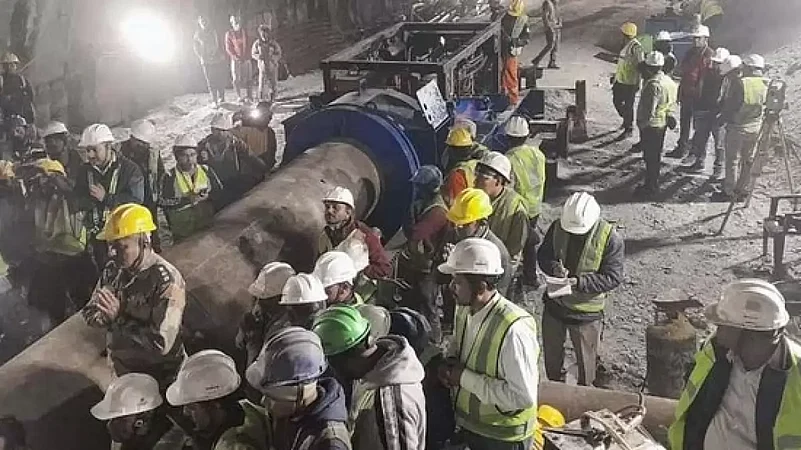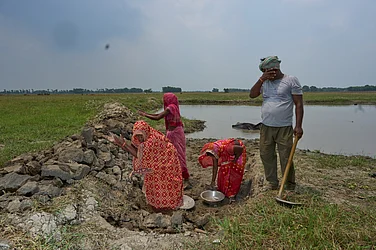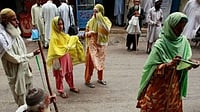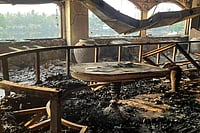A team of international experts has been brought to Uttarakhand's Uttarkashi to assist in the ongoing rescue efforts of 41 trapped workers.
The workers were trapped on November 12 when a part of the under-construction tunnel collapsed in Uttarkashi's Silkyara. The tunnel is part of the Char Dham Project, which has been flagged over environmental concerns over the years, owing to the fragility of the Himalayan geology.
While officials have maintained that workers are safe and have access to oxygen, food, and water being provided to them through pipes, no breakthrough has yet been made in the rescue operation. Multiple approaches have been tried so far, but none of them has so far proven to be successful.
Multiple government agencies, including the Indian Army and the various public sector undertakings, have been roped in to be part of the rescue operation. The tunnel was being constructed under the aegis of the National Highways & Infrastructure Development Corporation Limited (NHIDCL), a central public sector undertaking (PSU). As the mainstay approach, which included insertion of pipes through the rubble so the workers could crawl out, hit a snag, the rescuers are now working on a set of different approaches parallelly.
Here we share the latest updates related to the Uttarkashi rescue operation.
International experts brought to Uttarkashi
A team of international experts have been brought to Uttarkashi to assist in the rescue operation of the trapped workers.
International Tunnelling and Underground Space Association President Arnold Dix, part of the team, inspected the site of the accident and said that the team would deliberate on the plans with the rescuers and then figure out the way forward.
Speaking to ANI, Dix said he has "got the best experts for this Himalayan geology here".
Dix further said, "We are going back to the office to talk about what we've seen and we need to compare about what we have seen here above the tunnel with what we know about what is happening in the tunnel. This actually helps us make the proper decision because we are rescuing those 41 men and we are not letting anyone get hurt while we're doing that but to that, we need to be very careful."
Dix sounded optimistic about the rescue plan and said that "at the moment it's looking very positive".
"I need to see what's going on underneath, I need to go look down at the bottom, it's like any complex job you need to check all around it, and discuss it, but at the moment it's looking very positive...What I know is that something is going to happen. Things are happening, the team here is so focused on the rescue and so focused that no one is hurt that we are taking our time to make the very best decisions we can with the information we got, knowing that time is peaking," said Dix to ANI.
Visuals of Dix's inspection of the site of the tunnel have also surfaced. ANI said that he specialises in underground construction, transportation, and technical and safety issues related to such work.
What are the various options on the table?
On the eighth day of the rescue operations, multiple options are being worked out as the initial approaches hit roadblocks.
After the first machine proved to be insufficient, a heavier US-made machine was brought to drill through the rubble. The idea was to insert pipes through the rubble. Through these pipes, the workers were supposed to crawl out. But the plan came to a halt after this machine too hit a snag.
Now, multiple options are on the table, including digging a vertical shaft from the top of the tunnel to reach the workers underneath and digging a tunnel from the other end to reach and extract the workers. For the purpose of the vertical digging, a road to the top of the tunnel has been built by the Border Roads Organisation (BRO) comprised of an Indian Army company. ANI reported that the Rail Vikas Nigam Limited (RVNL) would use the road to make a vertical pipeline for supply for essential items.
Furter detailing the rescue plans on the table, ANI reported:
- NHIDCL continues to drill from Silkyara end after working safety arrangements.
- Tehri Hydroelectric Development Corporation (THDC) will start work of micro tunnelling from Barkot end, the other side of the tunnel.
- Sutlej Jal Vidyut Nigam Limited (SJVNL) will do the vertical drilling.
- ONGC has also started the initial work for vertical drilling from Barkot end.



















_.jpg?w=200&auto=format%2Ccompress&fit=max)






